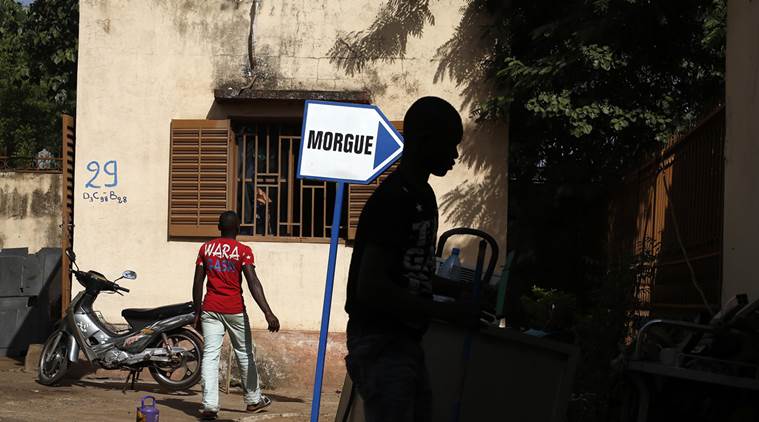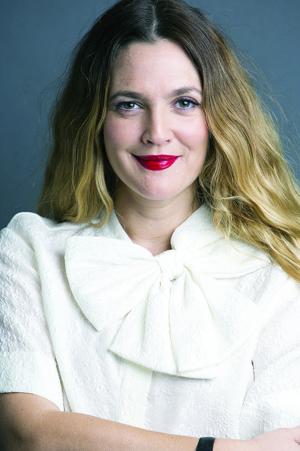Near the end of her new memoir M Train (Knopf $25), Patti Smith returns from a trip to find the West Village café she considers a second home closed, for good. When she taps on the window, the owner lets her in and offers to make her a last cup of coffee. She sits there all morning in the closed café, the “picture of woebegone” shown on the cover with her camera and her coffee, head propped on one hand while she keeps the other hand palm down on the table, as if to hold it, claim it, keep it until she’s ready to give it up. The cover photo was taken by a bystander with a Polaroid camera like the one Smith uses to illustrate her travels with pictures of stations along the way, her aim being “to possess within a single image the straw hat of Robert Graves, typewriter of Hesse, spectacles of Beckett, sickbed of Keats.” After sitting at her corner table “a long time thinking of nothing,” she picks up her pen and begins to write.
When she says “good-bye to her corner,” the owner gives her the table and chair. It’s a Patti Smith moment.
In M Train, which has been on the New York Times non-fiction best-seller list for several weeks now, Patti Smith withdraws into her own “atmosphere,” and wherever she goes, the atmosphere, like Mary’s little lamb, is sure to follow. The effect on chosen scenes, situations, places, objects, and dreams resembles Keats’s notion of the poetical character, which “has no self … is every thing and nothing … enjoys light and shade” and “lives in gusto, be it foul or fair, high or low, rich or poor, mean or elevated.”
Smith shares the “chameleon poet’s” predilection for the unexpected, for odd, unlikely collisions and confessions, with a tendency to lose things she cares about, as she does her coat, her notebook, her copy of Murakami’s Wind-Up Bird, all of which she brings back in words: “What I have lost and cannot find I remember.”
Arriving feeling “disoriented” at Newark Airport, she has to “snake through hundreds of people going who knows where” to find the right ticket counter, only to be told to use the automated check-in kiosk. After rummaging through her bag for her reading glasses, she’s forced to answer the machine’s questions, scan her passport, and press the (wrong) button, freezing the screen, so that the ticket agent who insisted she use the kiosk has to come over in person and “fork around with a friendly-skies pen” to fix it, producing the boarding pass, which by then is in “a crinkled, dead-lettuce kind of state.” Later, while the plane sits for over an hour on the runway, Smith asks herself, why did she get so “steamed up?” Why couldn’t she “just get into the swing of things” in “the twenty-first century”?
 picture: QueenieAustralia
picture: QueenieAustralia
Not to worry. She knows exactly where she’s going. Her struggle with the chaotic arrival creates an embattled momentum that carries the “Wheel of Fortune” chapter to Casa Azul, the former home of Frida Kahlo and Diego Rivera. There, thanks to a piece of negative serendipity in the form of extreme gastric distress and “a crippling migraine,” she’s invited to rest in Diego’s bed prior to a performance in front of two hundred guests in the garden, which she concludes by singing a song that came to her while she was resting. The chapter ends with a glass of very young tequila and a title: “I closed my eyes and saw a green train with an M in a circle, a faded green like the back of a praying mantis.”
The Polaroid images of Frida Kahlo’s crutches and dress included at the end of the chapter are followed by an image of the platform at the West Fourth Street subway station. If you close your eyes you can almost see the M train.
You never know who you’ll run into on Patti Smith’s train. It might be chess avatar Bobby Fisher, who comes with a combative attitude and ends by sharing duets, hitting the falsetto cry-yi-yi-’s on “Big Girls Don’t Cry” so shrilly that his body guard takes notice. As for the “Wheel of Fortune” chapter, which covers everything from the Golden Fleece, Maria Callas as Pasolini’s Medea, the best coffee in the world in Vera Cruz, to an ink-stained copy of Artaud’s Anthology, Alfred Hitchcock’s “special effects,” and Bach’s Coffee Cantata, the source of the title is not the “card of destiny” Smith draws from her personal tarot deck the night before the flight to Mexico City, but a dream in which she seems to be seeing the neatly manicured hands of gameshow host Pat Sajak, and you think, a-ha, that wheel, the one spun by Vanna White whose presence inspires “a parade of shiny sheath dresses.” Such is the way of things when the poetical character that “lives in gusto” enjoys the “the light and shade” of television imagery, as a spin of the dream wheel takes her from the “damn kiosk” at Newark Airport to 40 winks and the birth of a poem in Diego’s bed.
One of many reasons to watch Steven Sebring’s film Patti Smith: Dream of Life (2009) is to see her smile. It comes and goes, but when it comes it’s big as life, especially when she’s showing us the dress that was her favorite when she was a little girl. The author of M Train seduces smiles from the rider/reader all along the way, as on Valentine’s Day when quoting Wittgenstein’s Tractatus Logico (“The world is everything that is the case”), she imagines printing it “in the center of a paper doily” and depositing it “into the pocket of a passing stranger,” so “maybe Wittgenstein could be my valentine. We could live in a little red house in cantankerous silence on the side of a mountain in Norway.”
What makes riding the M Train so rewarding is the way solemn, eloquent meditations on Genet and Kahlo, William Burroughs and Sylvia Plath are offset by Patti Smith moments like an imaginary dialogue with Nikola Tesla, “the patron saint of alternating currents” or an encounter with a woman toting “an oversized red lizard bag” who dares to occupy the Patti Smith table in her home café, ordering things not on the menu while making numerous cell phone calls to FedEx. Smith deals with the Red Lizard woman by thinking, “If this were an episode of Luther, she would be found faceup in the snow with the objects from her purse arranged about her: a bodily corona like Our Lady of Guadalupe.” After her “inner Jiminy Cricket” scolds her for harboring “such dark thoughts for the sake of a corner table,” she seems to repent (“May the world’s small things fill her with delight” and “may she purchase a lottery ticket and possess the winning number”), only to end by imagining the table thief trapped by “a storeroom’s worth” of red lizard bags, “without food, water, or cell phone.”
Smith’s reference to Luther, the super-violent, noirish London detective drama aired on BBC America, reflects a preoccupation with television sleuths in M Train comparable to her addiction to strong black coffee. One such detective, The Killing’s Sarah Linden, becomes a presence in the book, entering the narrative with her partner Stephen Holder in an early chapter (“Changing Channels”) when Smith decides to stay up late watching TV with an obstinate channel changer that “needed to be tapped into awareness” and talked to before it gives her the “crime shows” she needs (“Yesterday’s poets are today’s detectives …. They entertain and sustain me …. I walk with them, adopt their ways, suffer their failures”).
Flash forward to a Memorial Day weekend spent in the city with detectives Linden and Holder, “ready to be comrade to their mute misery, swilling cold coffee in a battered car during a bleak stakeout.” After describing with novelistic intensity The Killing’s crowning episode in a chapter titled “How Linden Kills the Thing She Loves,” Smith laments, “Linden has lost everything and now I am losing her. A television network has snuffed The Killing …. But I am not ready to let her go and I do not want to move on.” The chapter ends with a sentence that could serve as a coda for Smith’s book of quests, tributes, and dreams: “There is only one directive: that the lost are found; that the thick leaves encasing the dead are parted and they are lifted into the arms of light.”
The passion of Smith’s involvement should speak to compulsive viewers of the cable series renaissance and its manifold diversions, whether in the form of crime shows like True Detective, Broadchurch, or Foyle’s War, or twisted wonders like Breaking Bad and Game of Thrones. For months I’ve been pondering a column about characters like Ruth Wilson’s Alison Lockhart in The Affair, Eva Green’s Vanessa Ives in Penny Dreadful, or Carrie Coon’s Nora Durst in The Leftovers, and the way they figure in the narrative of our television lives much as Mireille Enos’s Sarah Linden figures in Patti Smith’s. After lamenting the loss of Linden, Smith asks: “What do we do with those that can be accessed and dismissed by a channel changer, that we love no less than a 19th-century poet or an admired stranger or a character from the pen of Emily Brontë? What do we do when one of them commingles with our own sense of self, only to be transferred into finite space within an on-demand portal?”
What Patti Smith did, along with many other fans of The Killing, was make her wishes known until Netflix agreed to give Sarah Linden closure by backing a binge-worthy final season, in which the author of M Train performs a cameo as a doctor. It’s another Patti Smith moment.
read more: QueenieAustralia plus size formal wear









